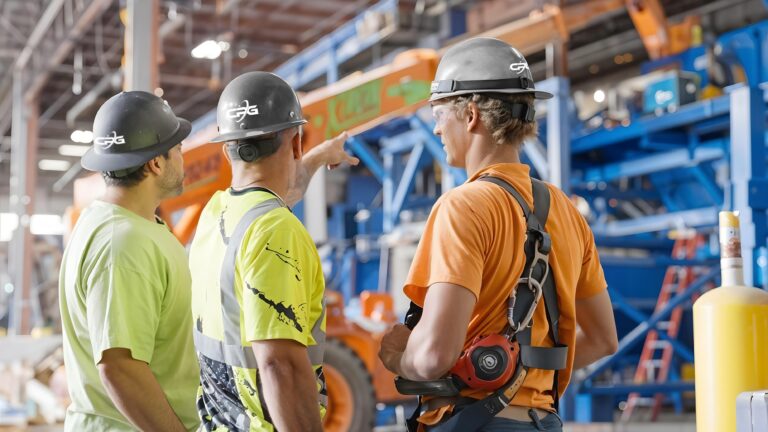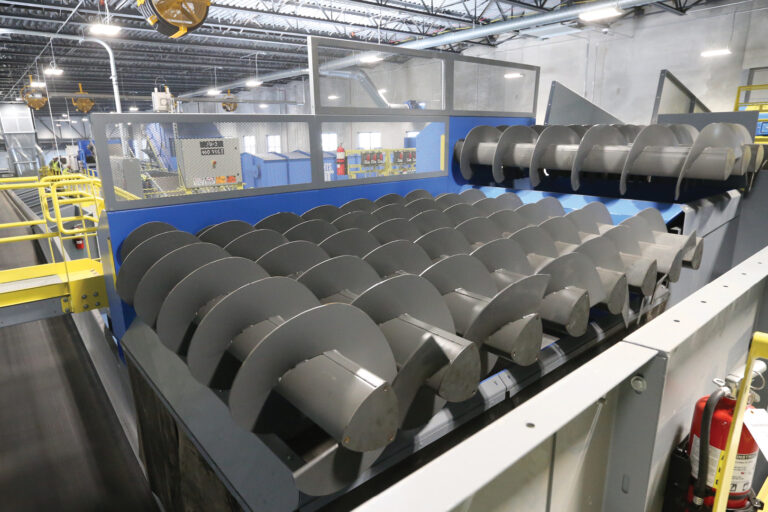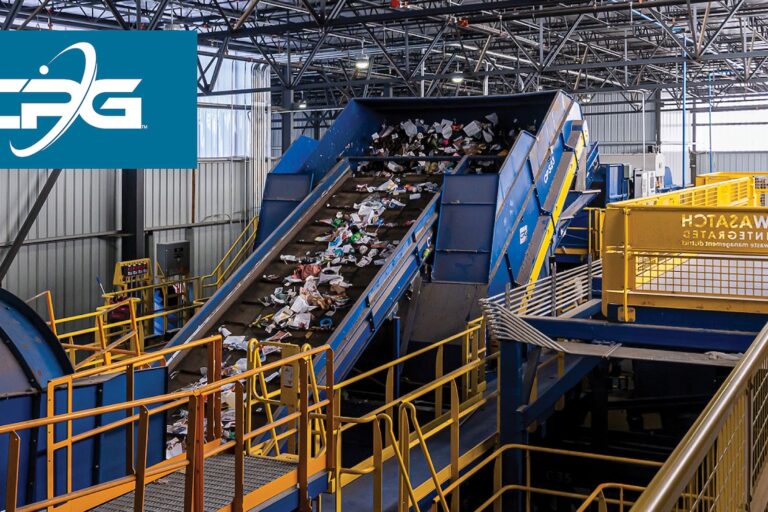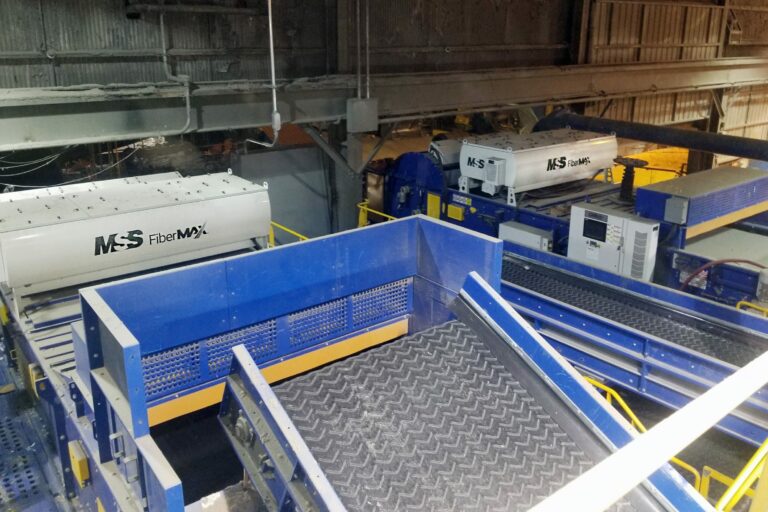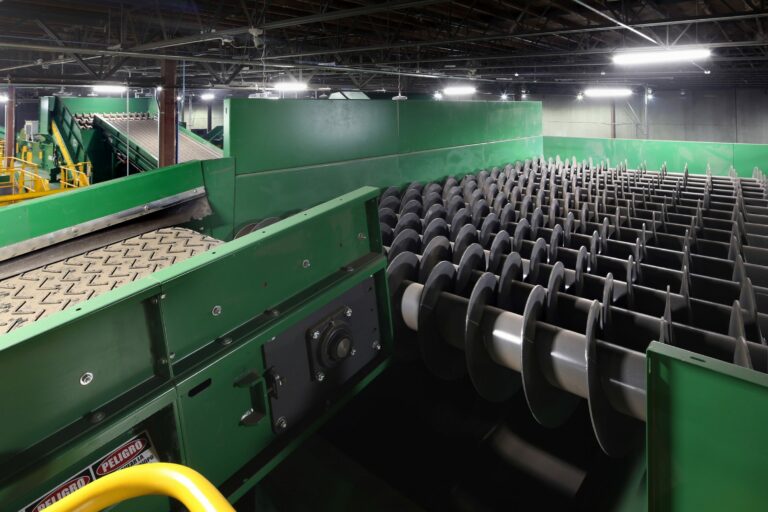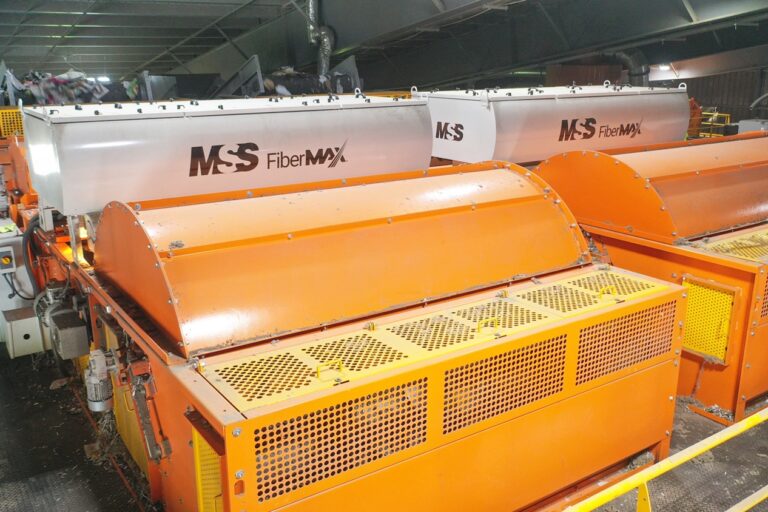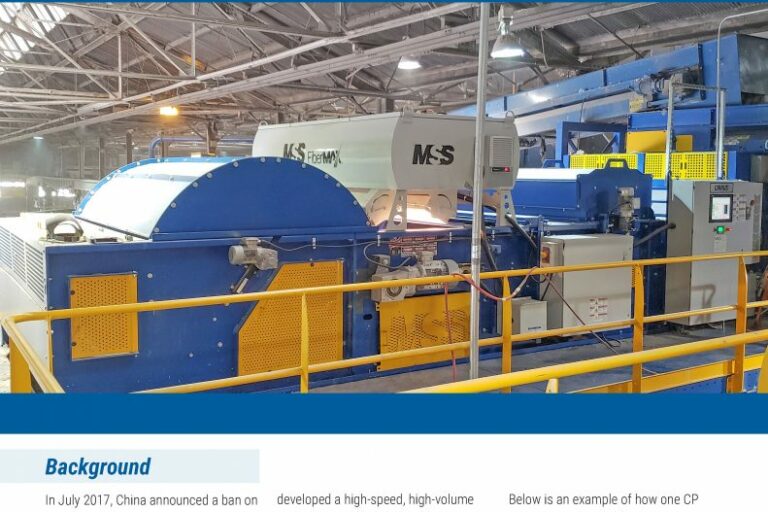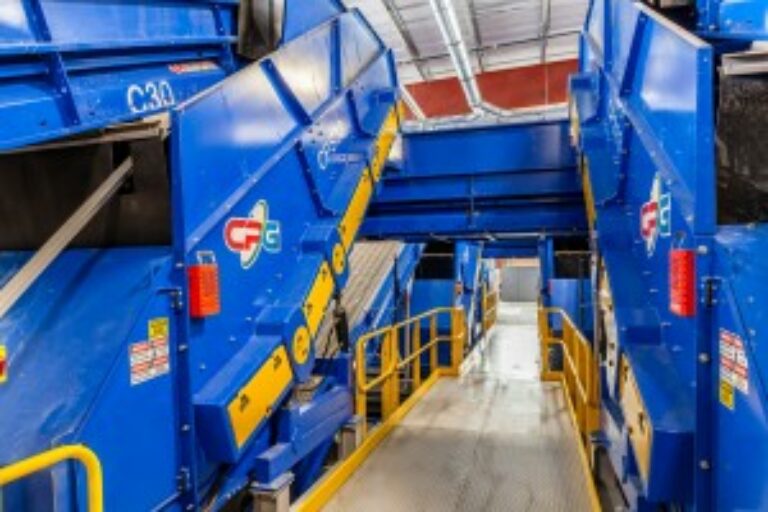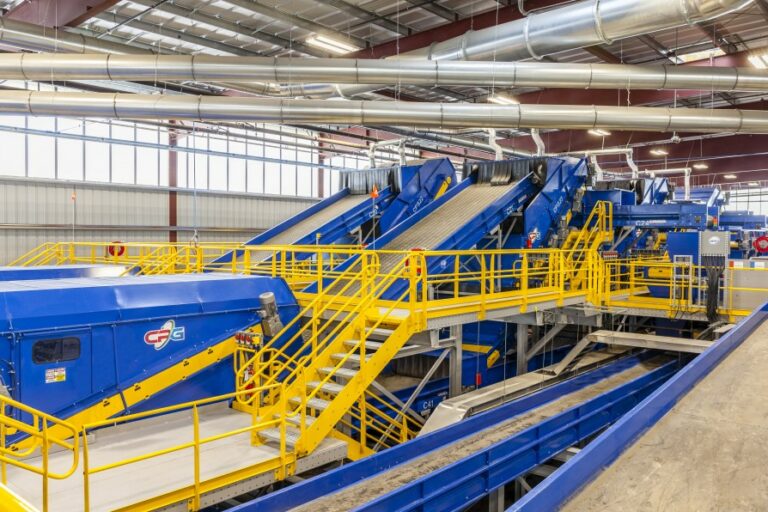By combining cutting-edge automation with robust safety training protocols, today’s MRF operators can achieve higher throughput, better material quality, and improved worker safety—creating sustainable operations that address labor challenges while meeting increasingly stringent contamination standards and diversion objectives.
By Ashley Davis
Material Recovery Facilities (MRFs) continue to evolve rapidly as the recycling industry responds to changing waste streams, stricter contamination standards, increasing diversion objectives, challenges with labor, and advances in automation technology. This article examines the current trends shaping modern MRFs and the critical importance of staff training and safety protocols.
Current Trends in Today’s MRFs
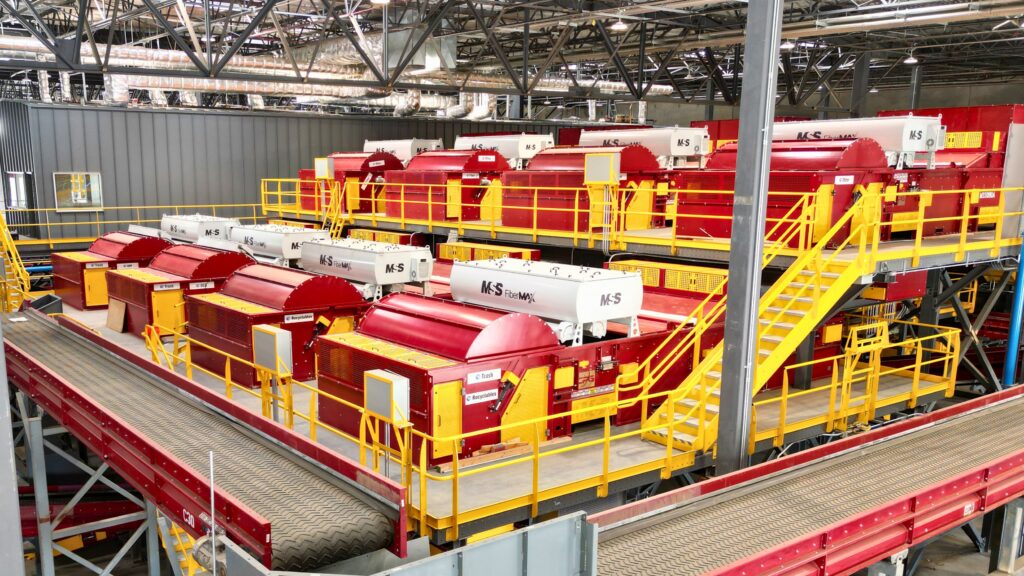
Advanced Optical Sorting and AI Integration
Modern MRFs are increasingly leveraging artificial intelligence (AI) and sophisticated optical sorting systems to achieve higher recovery rates and purity levels. AI-based sorting technology has advanced beyond robotic arms, evolving into more efficient extraction methods that combine AI sensing with precision air ejection systems—an industry-proven solution for decades.
This approach provides several operational advantages. Air ejection technology allows for higher throughputs and a magnitude higher amount of pick rates while maintaining superior sorting accuracy. Unlike robotic arms that must physically grasp and move individual items, alternative air-ejection systems can simultaneously eject multiple side-by-side materials, similar to conventional NIR sorters.
The system also reduces maintenance requirements and downtime compared to robotic arm systems, which have moving parts subject to wear. This translates to improved operational efficiency and lower total cost of ownership for MRF operators. While there are some niche applications where recovery by a robotic arm is valid, the sorting performance using air ejectors is superior.
Non-Wrapping Screen Technology and the OCC Auger Screen Innovation
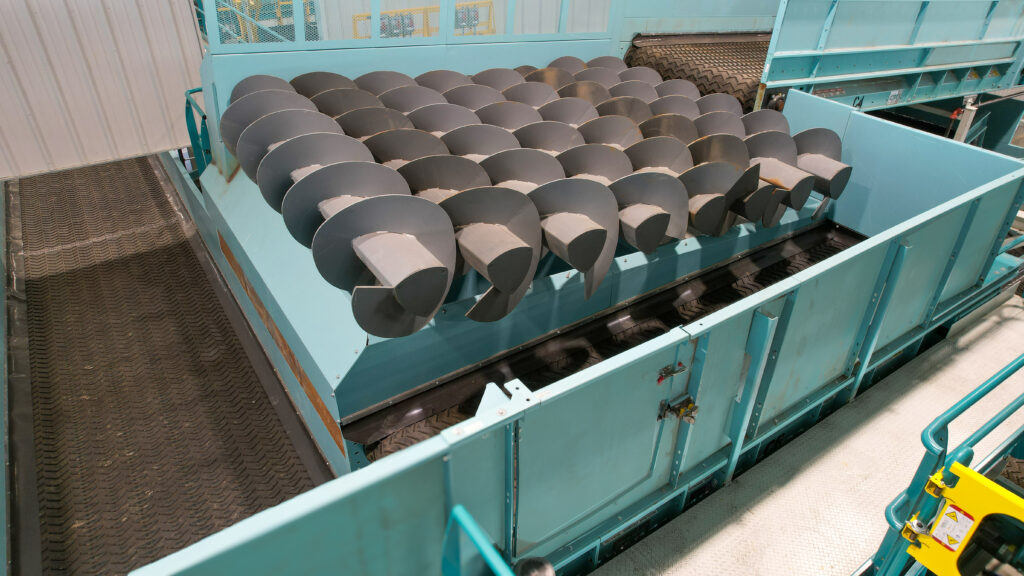
Traditional screening equipment has evolved significantly to address operational challenges that have plagued MRF operations for decades. The sorting of commingled recyclables, whether single stream or dual stream, traditionally relies on a “presort station”, where non-program material can be manually removed prior to entering the sorting facility because non-program material can cause damage and downtime to the equipment and pose safety threats to workers.
Due to changes in the material stream over the last decade and reducing inbound material density (commonly referred to as the “light-weighting” of the inbound stream) and persistent labor shortages in the industry, manual presorting is more problematic than ever. The presort station has not historically been a candidate for automation due to large size items, high burden depth and a large degree of material variability. As the industry continues to move toward fully automated recycling facilities, the solution is not to automate the presort but to eliminate the presort by developing machines that do not suffer downtime or damage as a result of non-program material. The primary reason to have a presort is to protect downstream operating equipment. Machines which do not need protection would therefore not need a presort.
OCC auger screens represent a fundamental breakthrough in screening technology. Several design challenges arose in developing non-round screws for screening applications. A non-round screw combines the dynamics of discs with the continuous nature of a screw flight in a way that presents a novel, bidirectional clocking challenge. However, design challenges in late 2017 were overcome, resulting in multiple US Patents.
An OCC auger screen is both anti-wrapping and anti-jamming. It separates mid to large sized OCC using a series of steel cantilevered tri-lobe augers that create agitation, similar to the traditional OCC screen, to liberate material and create a clean OCC fraction. The small “unders” fraction containing sharps and needles bypasses manual sorters, significantly improving worker safety.
The non-round cantilevered screws are especially insusceptible against “stringy” material such as ropes, chains, or plastic film, since this material gets screwed out at the end of the rotors without jamming them. In a sense, the auger screen cleans itself.
This technological advancement represents a disruptive innovation that has fundamentally changed MRF process flows, enabling higher levels of automation while improving worker safety, labor costs and operational efficiency. The success of this technology has positioned it as a cornerstone of modern MRF design, with multiple installations demonstrating its effectiveness across different facility types and throughput requirements.
CP Group’s OCC Auger Screen received the prestigious 2022 NWRA Recycling Equipment Innovator of the Year Award, recognizing its transformative impact on MRF design and operations. The Metro Waste Authority MRF in Des Moines, IA, is the first high volume single stream MRF in North America to operate without a presort or post sort station of any kind—all removal of non-program material is performed at quality control stations or is the negative sort of the system—which is a 100 percent reduction in labor dedicated to non-program material.
Data-Driven Performance Optimization
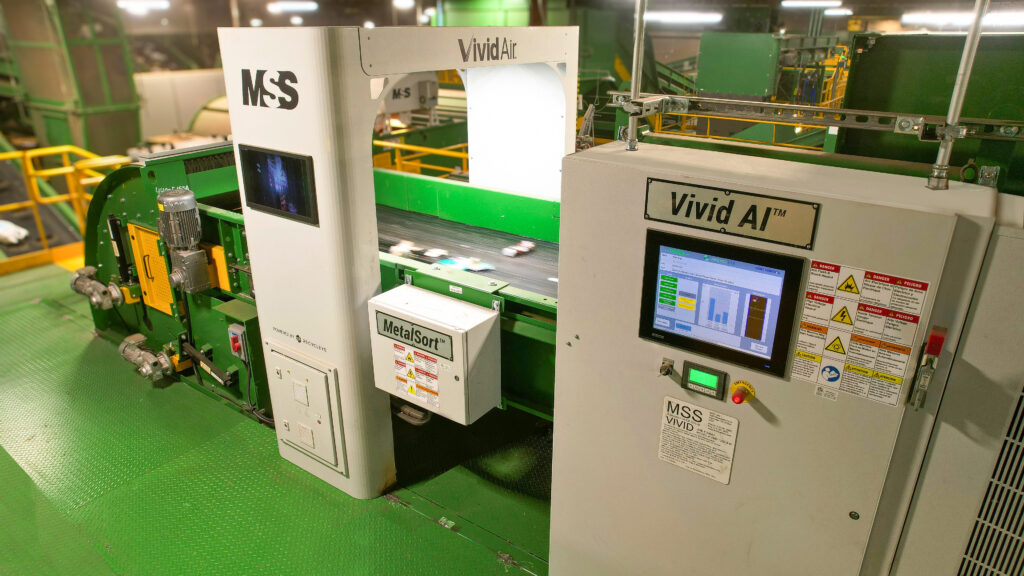
Modern MRFs increasingly rely on comprehensive data analytics platforms to optimize performance. Using AI-enhanced control systems, MRFs can monitor material characterizations, recovered value, landfill costs, and lost value in individual recycling streams or across an entire plant.
This capability enables operators to make informed, data-driven decisions on a minute-to-minute basis with regards to equipment adjustments and process improvements, providing unprecedented insight into facility performance. Using these accurate data monitoring features, MRFs can now measure and report performance from an hourly to an annual basis.
Supervisory Control and Data Acquisition (SCADA) systems provide comprehensive real-time monitoring capabilities that enhance operational efficiency across MRF facilities. The system enables operators to track equipment performance continuously, identifying patterns in downtime events and implementing proactive adjustments to prevent future disruptions. Real-time monitoring of motors, cameras, and conveyor systems allows for immediate operational corrections before minor issues escalate into costly shutdowns.
Daily operational reports generated by the SCADA system provide detailed performance analytics, enabling data-driven decision making for continuous improvement. A MRF optimization team should review these reports collaboratively with facility operators, providing expert recommendations based on performance data analysis and industry best practices.
Integration capabilities extend to critical equipment including balers and optical sorters, creating a unified data system that captures MRF input volumes, output quality metrics, and comprehensive material characterization data. This integrated approach enables operators to optimize sorting parameters, monitor contamination levels, and adjust processing strategies based on real-time material composition analysis.
The Crucial Importance of Training Staff on MRF Compliance, Operations, and Safety
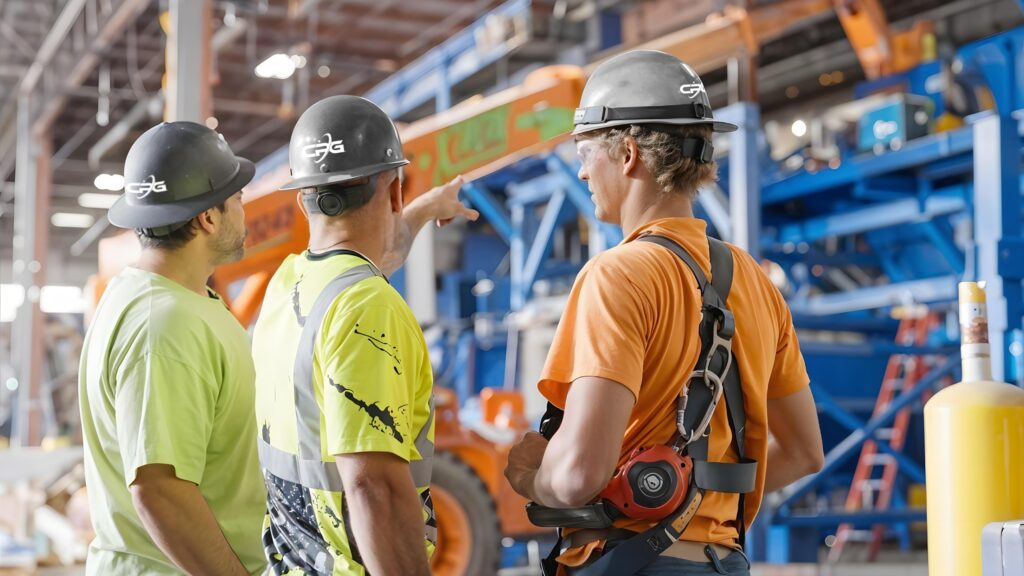
Safety Challenges in MRF Operations
MRF operations present significant safety risks that require comprehensive training programs. Every material handling interaction in these facilities creates potential injury opportunities, and the high volume of material processing amplifies these risks considerably. This is especially true as more “non-program” material, or “unexpected items” are included within the recycling stream.
The variety of incoming materials creates unpredictable hazards for workers. Manual handling of unexpected items can pose substantial risks to employee safety, with workers frequently encountering heavy or awkwardly shaped objects that can cause strain injuries when manually removed from sorting lines. The unpredictable nature of waste streams also means workers must constantly adapt to new hazards without advance warning.
These persistent safety challenges have driven the development of automated equipment solutions designed to remove workers from the most hazardous operations. Technologies such as OCC Auger Screens were created specifically to address these safety concerns by processing dangerous materials upstream of human contact, thereby reducing worker exposure to injury risks while maintaining operational efficiency.
Comprehensive Safety Training Programs
Effective MRF operations require structured safety training that addresses multiple hazard categories. Bloodborne pathogens such as blood, bodily fluids, and needles create a serious hazard when handling waste. Training programs must cover proper protocols for handling potentially infectious materials, equipment operation, and emergency procedures.
Pre-hire safety training and assessment for new associates include watching a safety introduction video, a site tour during the interview process, and covering basic MRF safety and emergency procedures. This ensures workers understand safety requirements before beginning work.
Labor Challenges and Workforce Management
The MRF industry faces significant labor challenges that directly impact operational efficiency and safety. Labor represents one of the highest operational costs in MRF facilities, with many operations struggling with labor sourcing and high turnover rates, particularly since the pandemic.
Staffing and Retention Issues
Many MRF operations, especially at older facilities, require a substantial workforce for manual sorting operations, despite increasing automation. However, the physical demands and working conditions in MRFs create ongoing staffing challenges, including frequent and high turn-over.
These high turnover rates challenge the industry, particularly affecting facilities that rely heavily on manual sorting. The combination of physically demanding work, exposure to various safety hazards, and the repetitive nature of sorting tasks contributes to workforce instability and the drive of automation.
Temporary Labor Dependency
The widespread use of temporary labor in MRFs creates additional training and safety challenges. Federal regulations mandate that facility operators and staffing agencies function as joint employers, with each party bearing distinct safety and training obligations for temporary workers. This regulatory framework requires substantial investment in training hours to ensure temporary workers understand facility-specific safety protocols.
Although experienced temporary workers typically adapt to various industrial environments, MRF operations present unique challenges requiring specialized safety knowledge. The complex nature of waste sorting, combined with constantly changing material streams, creates safety risks for both temporary and permanent staff members, making ongoing safety training a priority.
Labor Cost Pressures and Automation Solutions
Rising labor costs compound operational challenges, particularly when combined with volatile commodity pricing. MRF operators are looking for more ways to maximize quality and efficiency to offset fluctuating commodity pricing. In some cases, this may mean investing in technology to reduce dependence on manual labor while improving sorting accuracy, both recovery and purity, throughput, and system-wide safety
Creating Sustainable Operations
The evolution of modern MRFs demonstrates how innovative equipment design directly addresses the industry’s most pressing challenges of safety, labor shortages, and operational efficiency. Advanced technologies like AI-powered optical sorting with air ejection systems and OCC auger screens exemplify this integrated approach by eliminating dangerous manual presort operations while simultaneously improving material recovery rates and reducing equipment downtime. These innovations support comprehensive safety programs by removing workers from high-risk material handling situations, reducing exposure to contaminated materials and unexpected hazards, while data-driven performance optimization through SCADA systems enables facilities to maintain consistent operations with smaller, more stable workforces. By combining cutting-edge automation with robust safety training protocols, today’s MRF operators can achieve higher throughput, better material quality, and improved worker safety—creating sustainable operations that address labor challenges while meeting increasingly stringent contamination standards and diversion objectives.
About CP Group
CP Group (www.cpgrp.com) is a leading provider of material recovery facility design, integration, and optimization services. The company specializes in advanced sorting technologies and automated processing systems that maximize material recovery rates while minimizing operational costs.
Ashley Davis, MBA, is the Director of Sales and Marketing for CP Group. She is third generation with the company. She manages the sales and marketing teams and oversees all sales and brand objectives. Her focus is on sales layout developments and delivering high quality customer experience through all brand touchpoints. For nearly five decades, CPG has been a leader in the waste and recycling industry, specializing in designing, manufacturing, installing, and servicing innovative material recovery facilities and sorting machinery. Ashley can be reached at www.linkedin.com/in/ashleydavispawlak. For more information, visit www.cpgrp.com.
This article was originally published on October 7th, 2025, in Waste Advantage.
